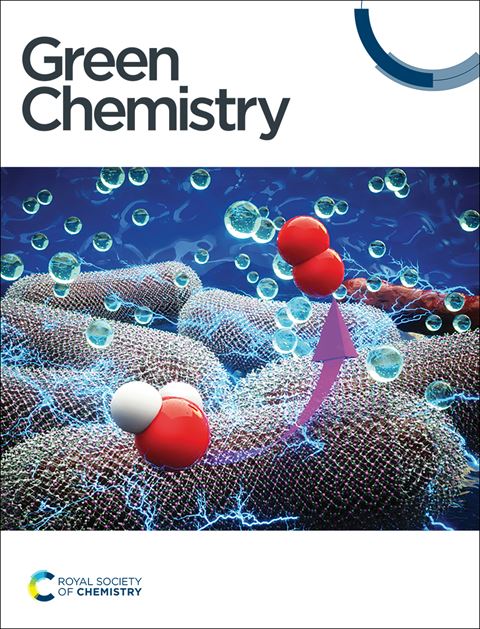Facile depolymerization of lignin into phenolics via self-hydrogen transfer hydrogenolysis over a skeletal CuZnAl catalyst†
IF 9.3
1区 化学
Q1 CHEMISTRY, MULTIDISCIPLINARY
引用次数: 0
Abstract
Self-hydrogen transfer hydrogenolysis (STH) has emerged as an effective approach for lignin depolymerization to phenolics due to its high atomic and energy efficiency. However, the development of a non-noble and efficient catalytic system remains a pivotal challenge. Herein, we report a facile and non-noble skeletal CuZnAl catalyst for the STH of lignin dimer 2-phenoxy-1-phenylethanol (α-OH-PPE). The reaction offered a 92% yield of acetophenone and a 92% yield of phenol at a mild reaction temperature of 160 °C under a N2 atmosphere. STH of organosolv lignin provided a 56 wt% lignin oil, with 30 wt% identified as aromatic monomers at 200 °C. Catalyst characterization and mechanistic studies revealed that Cu0 sites and oxygenated metal species on the catalyst's surface synergistically contributed to the dehydrogenation of hydroxyl groups and the cleavage of C–O bonds in lignin. A trace amount of water was revealed to promote the hydrogenolysis of the C–O bond through the protonation of O atoms in the C–O linkage. This current work provides a new and practical catalytic method for the STH of lignin, which adds to the catalyst family for lignin depolymerization and also holds great potential for industrial application.
木质素在骨架CuZnAl催化剂上的自氢转移氢解反应中易解聚成酚类
自氢转移氢解(STH)由于其较高的原子效率和能量效率而成为木质素解聚成酚类化合物的有效途径。然而,开发一种非高贵而高效的催化体系仍然是一个关键的挑战。本文报道了木质素二聚体2-苯氧基-1-苯乙醇(α-OH-PPE)的催化催化活性。在N2气氛下,反应温度为160℃,苯乙酮和苯酚的产率分别为92%和92%。在200℃下,有机溶剂木质素提供56 wt%的木质素油,其中30 wt%被鉴定为芳香单体。催化剂的表征和机理研究表明,催化剂表面的Cu0位点和氧化金属具有协同作用,促进了木质素中羟基的脱氢和C-O键的断裂。微量的水通过C-O键中O原子的质子化作用促进了C-O键的氢解。本研究为木质素解聚提供了一种新的实用的催化方法,增加了木质素解聚催化剂家族,具有很大的工业应用潜力。
本文章由计算机程序翻译,如有差异,请以英文原文为准。
求助全文
约1分钟内获得全文
求助全文
来源期刊

Green Chemistry
化学-化学综合
CiteScore
16.10
自引率
7.10%
发文量
677
审稿时长
1.4 months
期刊介绍:
Green Chemistry is a journal that provides a unique forum for the publication of innovative research on the development of alternative green and sustainable technologies. The scope of Green Chemistry is based on the definition proposed by Anastas and Warner (Green Chemistry: Theory and Practice, P T Anastas and J C Warner, Oxford University Press, Oxford, 1998), which defines green chemistry as the utilisation of a set of principles that reduces or eliminates the use or generation of hazardous substances in the design, manufacture and application of chemical products. Green Chemistry aims to reduce the environmental impact of the chemical enterprise by developing a technology base that is inherently non-toxic to living things and the environment. The journal welcomes submissions on all aspects of research relating to this endeavor and publishes original and significant cutting-edge research that is likely to be of wide general appeal. For a work to be published, it must present a significant advance in green chemistry, including a comparison with existing methods and a demonstration of advantages over those methods.
 求助内容:
求助内容: 应助结果提醒方式:
应助结果提醒方式:


